Kekova - Ancient City With The History Of Atlantis
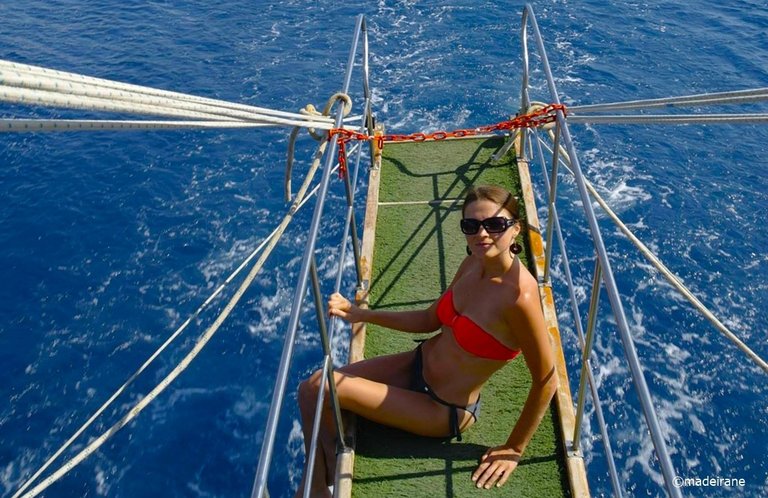
It is not for nothing that Turkey is called the Mecca of tourism: with due zeal, every vacationer can find anything here. The thing is that everything is organized in Turkey so that even if there was not a single sunk city in the whole country, I bet that the Turks themselves would have built some stone town and certainly flooded it. You can suck a dozen legends out of the finger, and then hundreds more different interpretations. In general, entire generations can feed on this.
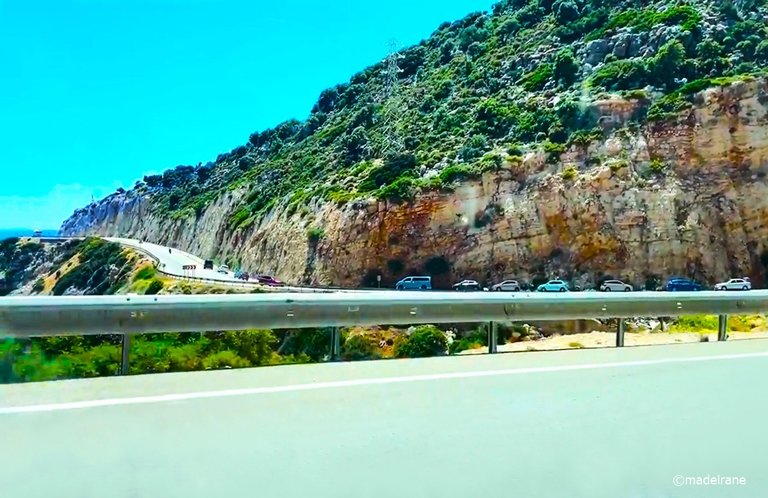
In the title of the famous triple Turkish excursion Demre-Mira-Kekova, this sunken city quite rightly got the last place. Even despite the fact that, in order to avoid large crowds of tourists, this excursion is put together in different ways. Namely, some agencies take people to the Church of St. Nicholas the Wonderworker in the city of Demre in the morning, and then to other places, while others leave the church for dessert, and start with Kekova. In any case, I would also put this city in the last place in the title of the triple excursion as the least significant. Firstly, in terms of organization and actual content. Below I will tell you in detail why.
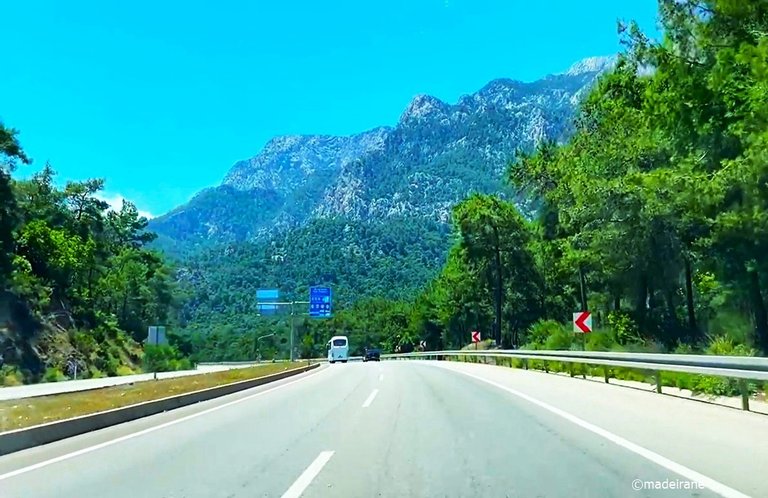
In terms of both the order of the visit and the quality of the excursion itself, it makes absolutely no difference whether you buy it from a street agency or from your hotel guide. Of course, if the street agency is not a random passerby, taking crumpled and greasy advertising brochures out of a shabby jacket, but at least a well-known tourist network along the entire coast. Saving, in comparison with the prices of the hotel guide, more than twice, namely, paying only twenty-five dollars per person with lunch included. This is for everything (except for the entrance to the temple), and not just for Kekova. If it were just for Kekova, I would have been even more disappointed.
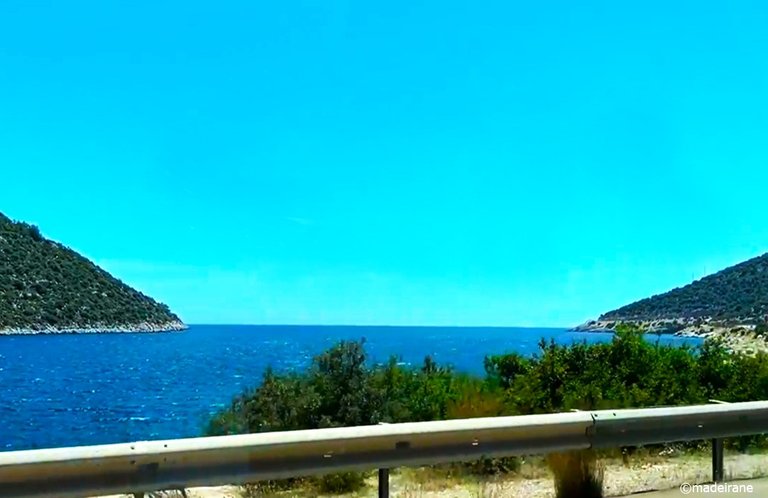

We were picked up from the hotel at five in the morning. At that moment, we already knew that we would be back only for dinner, so mentally we were already prepared for a whole day on wheels. In reality, everything was not so difficult, because there were many stops, and part of the triple excursion takes place on a yacht, and a solid part of the trip is on foot. Here I will tell you only about a third of our adventure, namely about the sunken city of Kekova, from which, as it happened, our triple excursion began.
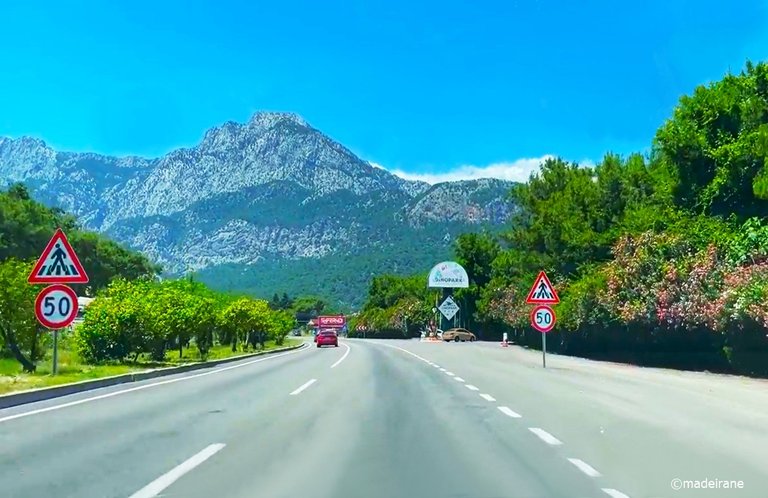
The road lay along mountain serpentines along the edge of the sea. I had previously driven a lot along various winding roads in the mountains, but to have such views, to see such stunning beaches along the way, to see the purest azure sea, to examine the rocks of ancient cliffs - this was the first time in my life. And I will remember this forever. Moreover, the road was quite flat, so it was very comfortable to look at and take pictures.
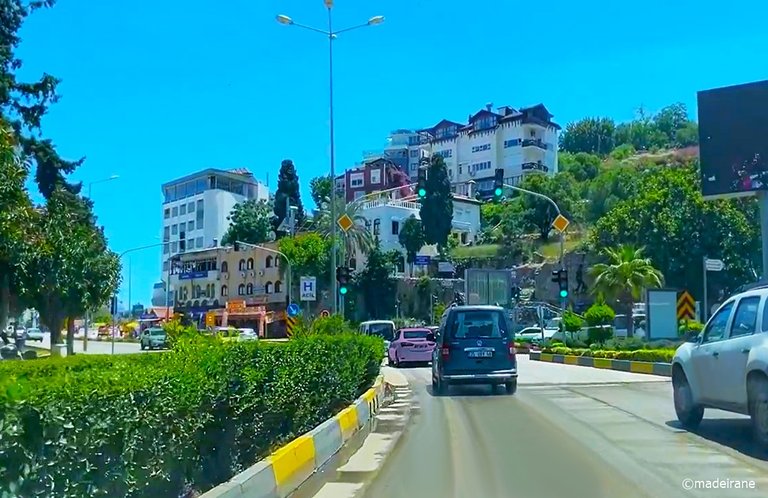
Upon arrival at the pier, we saw with our own eyes the process of chartering ships. That's why I said at the very beginning of the review that it makes no difference who you buy the excursion from. At the pier, we monitored the universal equality in action. And the guides of large operators and ordinary guides of street agencies all ran around the pier in search of a vessel that would be ready to take them and tourists on board.
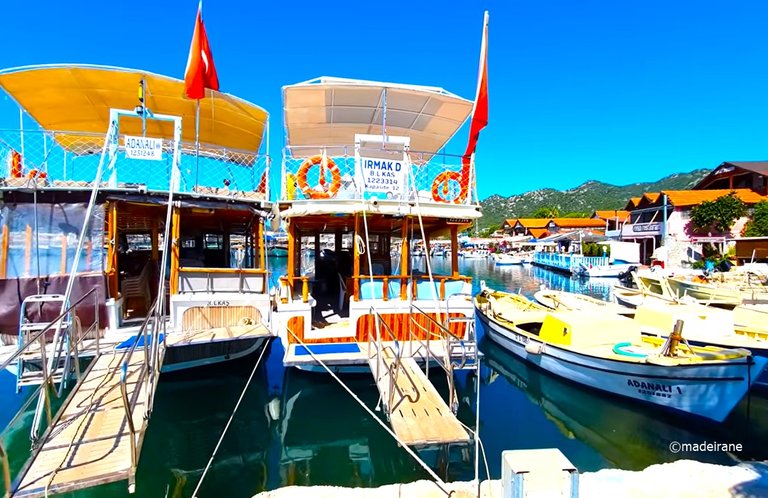
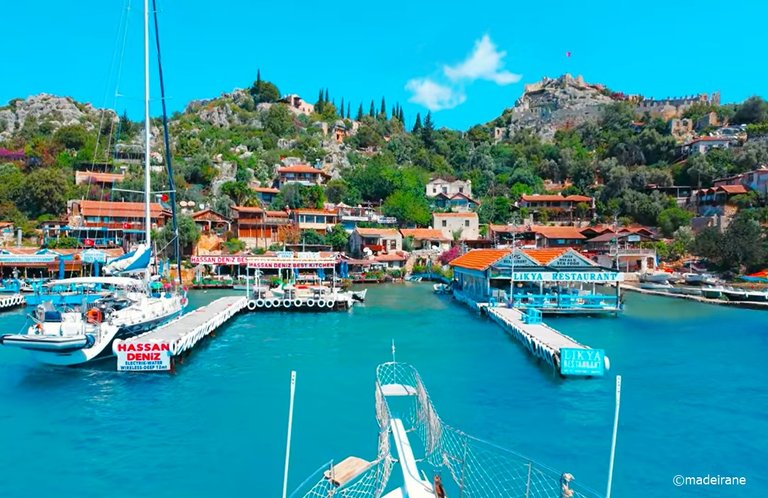
With great difficulty and, apparently, after a lot of bargaining, the guide invited us on board the vessel he had chosen. On top there are sunbathing areas, and below there are seating areas under a canopy, where tourists are protected from the sun and can finally eat their breakfast. It is worth noting that fresh food is also offered on board (usually fish and various fried seafood), but, of course, for an additional fee, approximately at restaurant prices.
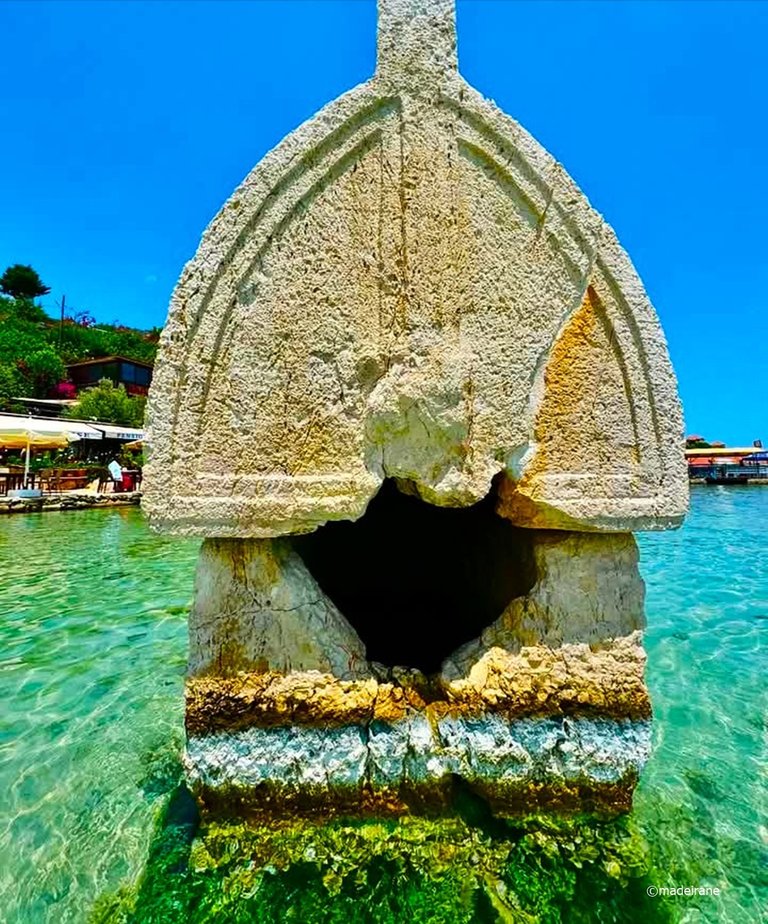
By the way, some of the tables are located right where the built-in floor portholes used to be. This is the notorious glass bottom of pleasure boats.
And here we are, finally, at sea. We are walking along the shore, like dozens of other yachts, to see the Turkish Atlantis. At that moment, despite numerous photographs and advertising brochures, I still believed that this excursion would not just be something unusual, but literally unforgettable. Of course, we are going to a sunken city! It's not every day, you know, that you get the opportunity to look at a city hidden under the thickness of water. But we love to believe in different fairy tales so much!
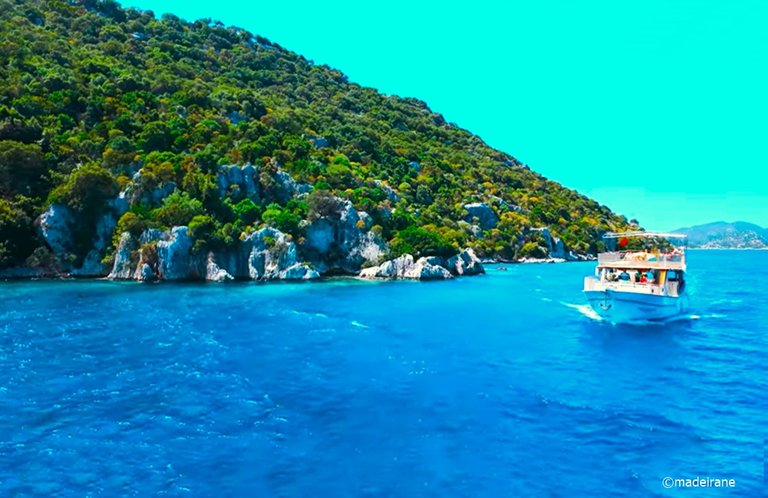
Honestly, when we got to the right place, at first I didn't even believe that this was it. Where? Where is the city itself? At least some streets, something like ancient Ephesus or Side, half-ruined columns or anything at all? Are these white-gray stones scattered around the bushes the famous Turkish Atlantis? I haven't been so disappointed in a long time.

It is forbidden to land on the shore (otherwise careless tourists will destroy the last remains). Moreover, you can't even stop a yacht near the shore. And it is understandable, the flow of tourists is huge, so here, traffic jams are extremely undesirable. One way or another, such a sea promenade along the shore at a distance of about tens of meters and lasting several minutes is actually all that can be seen there.
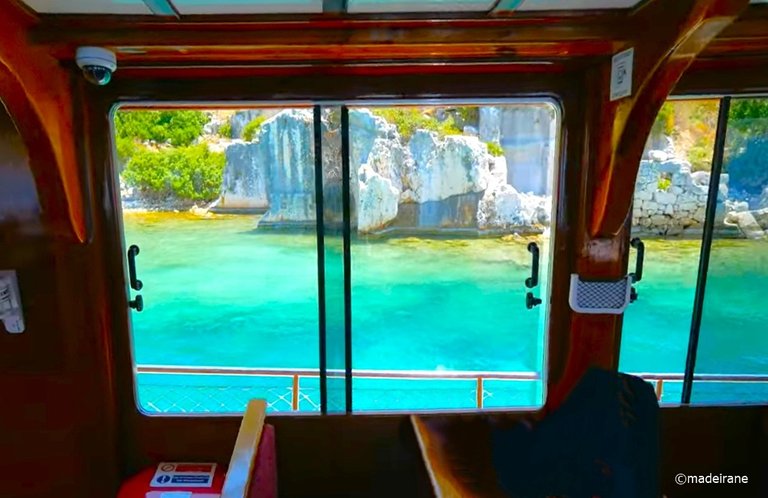
Glass bottom? The weather was fine, and the sea was calm, so there was no reason to complain about the muddy water. The water was normal, but no matter how hard we tried, we couldn’t see anything through those muddy windows except the water itself. Someone later said that he saw some pots, a turtle, some processed stones and fragments of smooth walls, but I myself couldn’t see absolutely anything. Maybe I was just unlucky. Therefore, all the impressions that remained were only of the coastline and some real sunken elements of the ancient city, which could be seen right overboard.
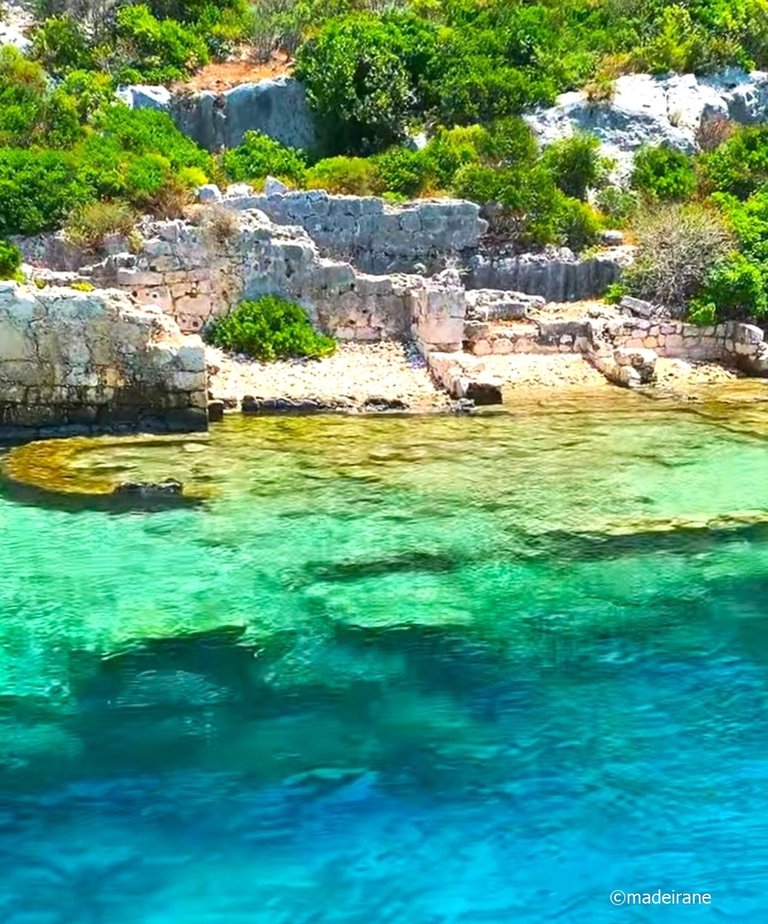
I was much more emotional about the goats grazing in such antiquity. At first, I was surprised because I thought they were wild. But the guide said that the locals still break the rules and swim to the island, landing their goats so that they graze on the island. In general, it turns out to be very convenient. You don’t have to watch them, since the goats have nowhere to escape.
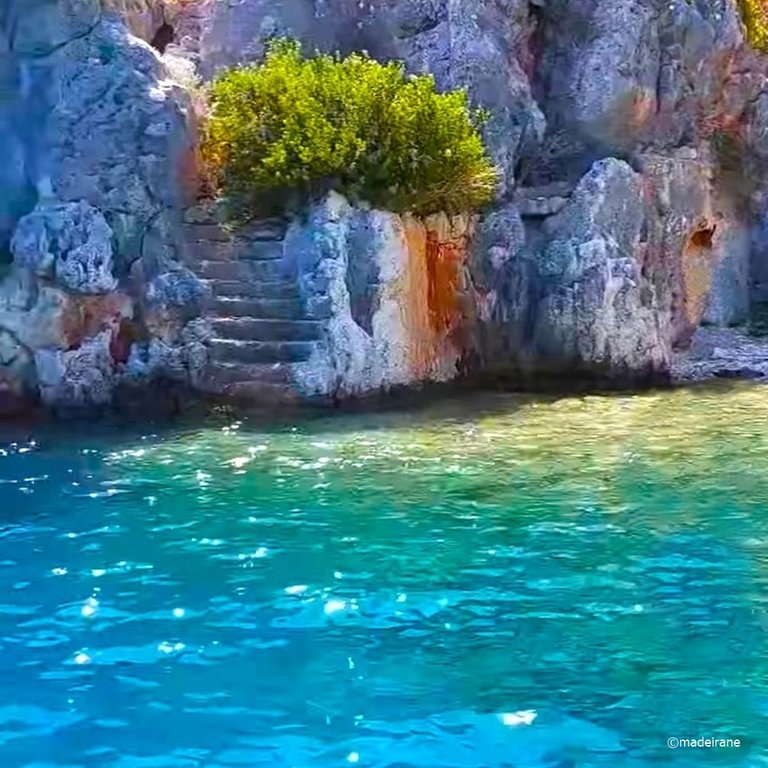
In some places, you could even stop at the surviving fragments of ancient stone structures. For example, where they are not on the shoreline, but rise directly from the water. In any case, I saw boats that released tourists for photo sessions on such debris, but ours just passed by. Well, at least we managed to see it from afar, which is already good.
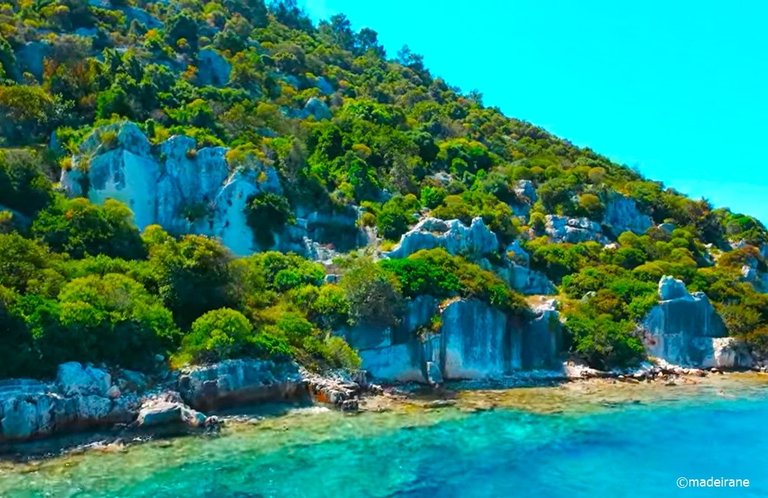
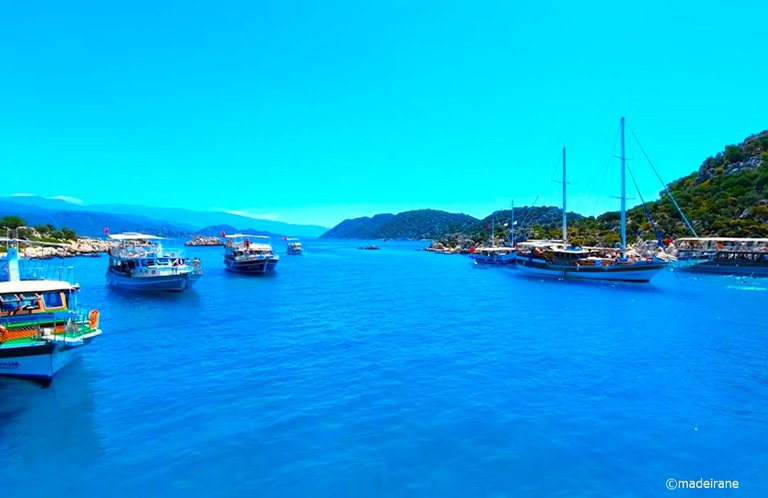
What else was there? Well-preserved stairs, carved right into the solid rock, fairly evenly laid-out stone walls, descents well cleared of stones, clear outlines of rooms and obvious transitions from level to level, there was quite a lot of all this and it immediately caught the eye. The color of the rock was uniform everywhere. Only near the water could one see strong darkening and traces of flowering. Thickets of bushes appeared everywhere, creating a persistent feeling that they were growing right out of the stone.
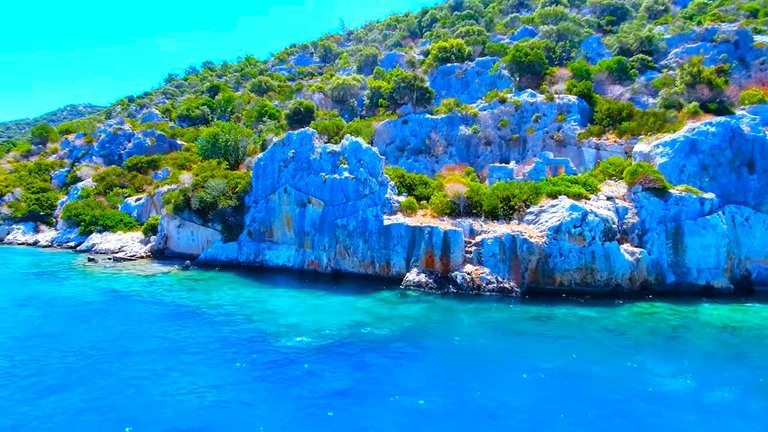
All kinds of sewage drain and other engineering structures were perfectly preserved and were easily recognizable. By the way, I liked them the most.
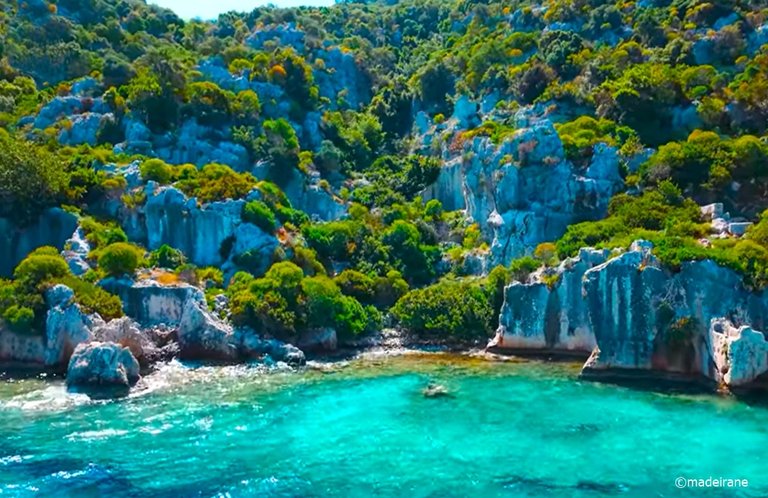
Somewhere, you can see religious symbols carved into the stones (usually crosses), and in some places you can even see things like doorways and arches. If the guide hadn't specifically drawn the tourists' attention to them, most of us probably wouldn't have even noticed them, but when you know where to look and what to look for, it's a matter of seconds, so you not only find them, but also take close-up photos as the yacht slowly passes by.
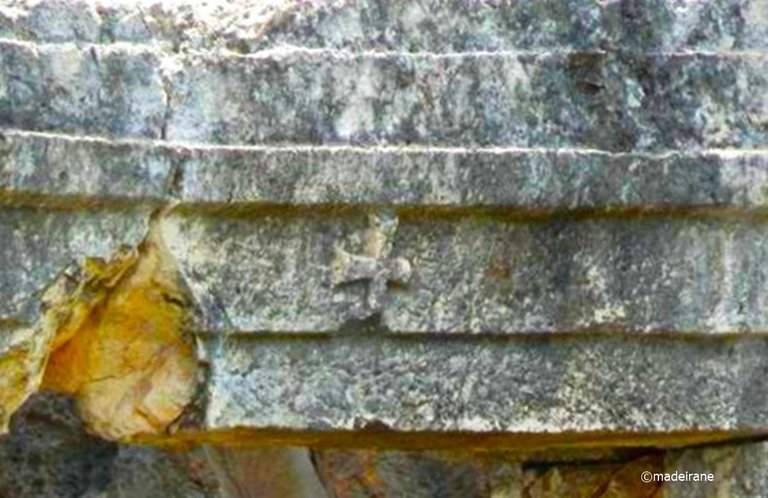
Not far from the island of Kekova you can see the city of Simena. At the highest point there is a well-preserved fortress with a Turkish flag.
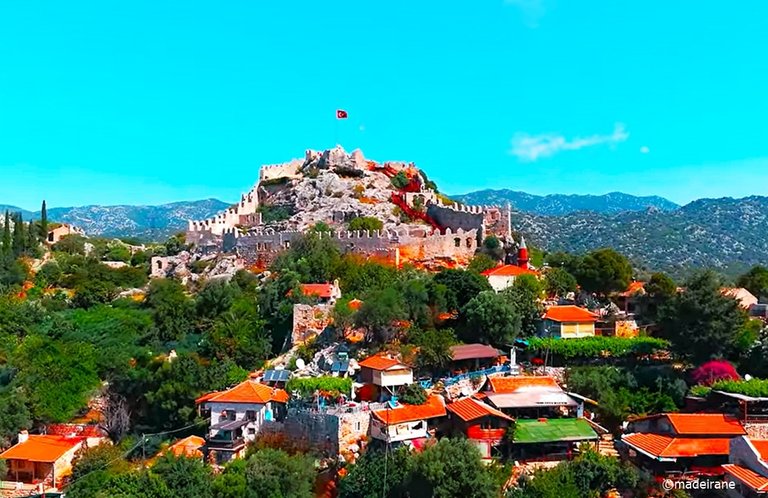
After we walked along the coastline and listened to the obligatory excursion, the yacht drifted where it was allowed to finally let people swim in the sea.I love swimming and was happy to take advantage of the long-awaited opportunity. Especially since the heat was terrible and I really wanted to swim.
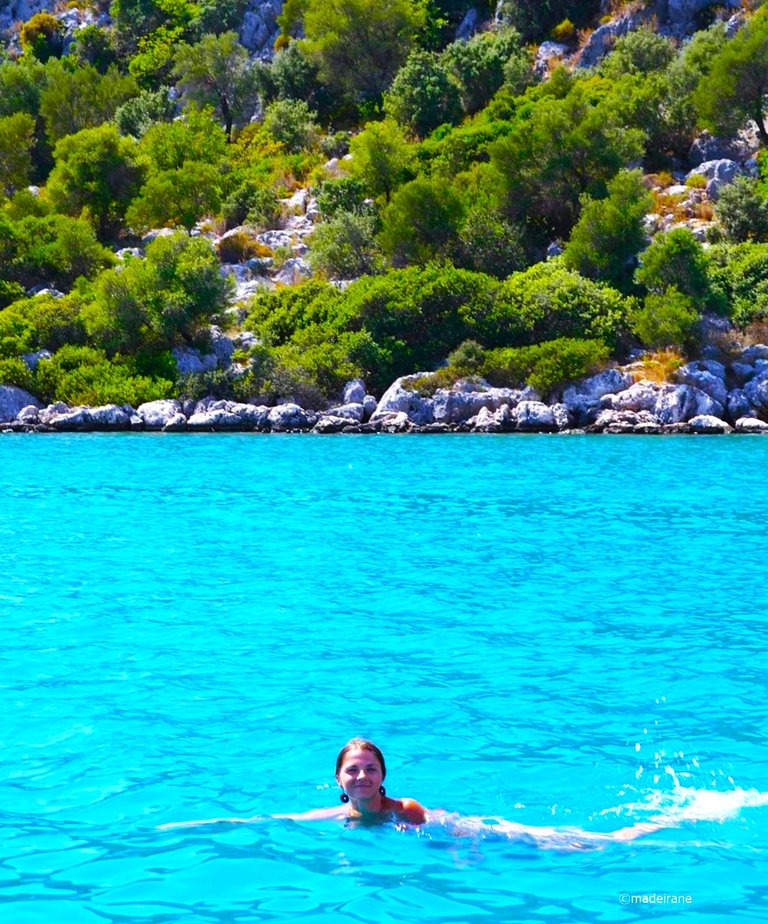
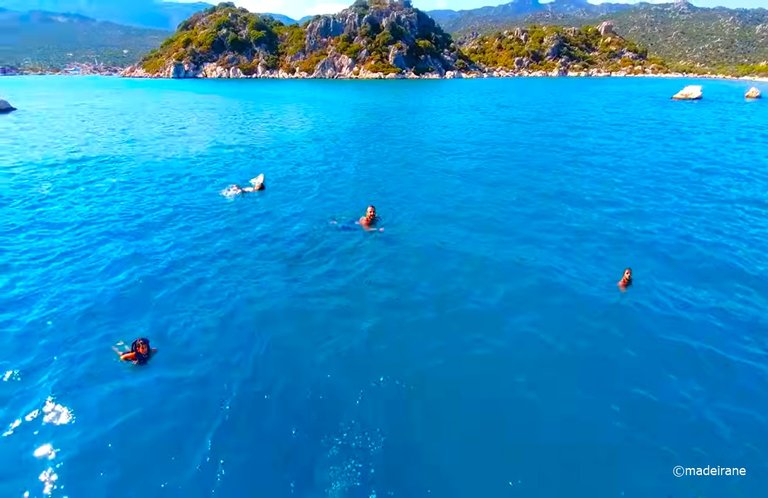
This swim was probably the most vivid memory from visiting the city of Kekova. It's good that after that we went to more interesting places, because if we had been brought here in the evening and already hungry, I think I would have felt nothing but irritation, but I was still full of hope and looking forward to further adventures.
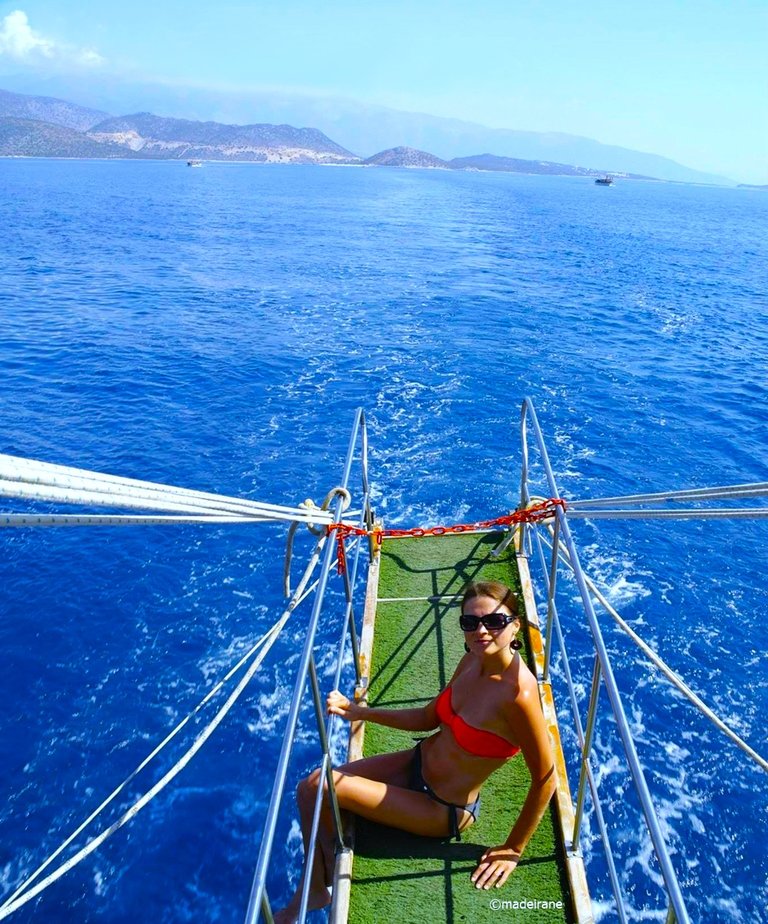
💝💝💝💝💝💝💝💝💝💝
With love @madeirane
Photos are taken by me.
© 2025
Translated from Lithuanian with DeepL.com (free version)
Ne veltui Turkija vadinama turizmo Meka: čia kiekvienas poilsiautojas gali rasti kažką sau. Reikalas tas, kad Turkijoje viskas organizuota taip, kad net jei visoje šalyje nebūtų nė vieno nuskendusio miesto, lažinuosi, kad patys turkai būtų pastatę kokį nors akmeninį miestą ir tikrai jį užtvindytų. Iš piršto galima išlaužti tuziną legendų, o paskui dar šimtus skirtingų interpretacijų. Apskritai tuo gali maitintis ištisos kartos.
Garsiosios trigubos turkiškos ekskursijos pavadinime Demrė-Mira-Kekova šiam nuskendusiam miestui visai pagrįstai atiteko paskutinė vieta. Net nepaisant to, kad, siekiant išvengti didelių turistų minių, ši ekskursija rengiama įvairiais būdais. Būtent, kai kurios agentūros iš ryto veža žmones į Demrės miesto Švento Mikalojaus Stebukladario bažnyčią, o paskui į kitas vietas, o kitos palieka bažnyčią desertui ir pradeda nuo Kekovos. Bet kuriuo atveju šį miestą taip pat įrašyčiau paskutinėje trigubos ekskursijos pavadinimo vietoje kaip mažiausiai reikšmingą. Pirma, organizaciniu ir faktinio turinio požiūriu. Toliau išsamiai papasakosiu, kodėl.
Tiek apsilankymo eiliškumo, tiek pačios ekskursijos kokybės požiūriu nėra jokio skirtumo, ar ekskursiją pirksite iš gatvės agentūros, ar iš viešbučio gido. Žinoma, jei gatvės agentūra yra ne atsitiktinis praeivis, ištraukiantis iš aptrintos striukės suglamžytus ir riebaluotus reklaminius lankstinukus, o bent jau gerai žinomas turistų tinklas visoje pakrantėje. Sutaupysite, palyginti su viešbučio gido kainomis, daugiau nei dvigubai su įskaičiuotais pietumis. Tai už viską (išskyrus įėjimą į šventyklą), o ne tik už Kekovą. Jei tai būtų tik už Kekovą, būčiau dar labiau nusivylusi.
Iš viešbučio mus paėmė penktą valandą ryto. Tuo metu jau žinojome, kad grįšime tik vakarienės, todėl psichologiškai jau buvome pasiruošę visai dienai ant ratų. Iš tikrųjų viskas nebuvo taip sunku, nes buvo daug sustojimų, be to, dalis trigubos ekskursijos vyksta jachtoje, o solidi kelionės dalis - pėsčiomis. Čia papasakosiu tik apie trečdalį mūsų nuotykių, būtent apie nuskendusį Kekovos miestą, nuo kurio, taip jau sutapo, prasidėjo mūsų triguba ekskursija.
Kelias driekėsi kalnų serpantinais palei jūros pakraštį. Anksčiau buvau daug važinėjusi įvairiais vingiuotais keliais kalnuose, bet kad atsivertų tokie vaizdai, kad pakeliui matytųsi tokie nuostabūs paplūdimiai, kad regėčiau tyriausią žydrą jūrą, apžiūrinėčiau senovinių uolų vaizdus - tai buvo pirmas kartas mano gyvenime. Ir tai prisiminsiu amžinai. Be to, kelias buvo gana lygus, todėl buvo labai patogu žiūrėti ir fotografuoti.
Atvykę į prieplauką, savo akimis pamatėme laivų frachtavimo procesą. Štai kodėl pačioje apžvalgos pradžioje sakiau, kad nėra jokio skirtumo, iš ko perkate ekskursiją. Prieplaukoje stebėjome, kaip veikia visuotinė lygybė. Ir didžiųjų operatorių gidai, ir eiliniai gatvės agentūrų gidai - visi bėgiojo po prieplauką ieškodami laivo, kuris būtų pasirengęs priimti juos ir turistus į laivą.
Su dideliu vargu ir, matyt, po ilgų derybų, gidas pakvietė mus į jo pasirinktą laivą. Viršuje įrengtos vietos deginimuisi, o apačioje - sėdimos vietos po stogu, kur turistai saugomi nuo saulės ir pagaliau gali pavalgyti pusryčius. Verta paminėti, kad laive taip pat siūlomas šviežias maistas (dažniausiai žuvis ir įvairios keptos jūros gėrybės), bet, žinoma, už papildomą mokestį, maždaug restorano kainomis.
Beje, kai kurie stalai stovi ten, kur anksčiau buvo įmontuoti grindų iliuminatoriai. Tai liūdnai pagarsėjęs stiklinis pramoginių laivų dugnas.
Ir štai mes pagaliau esame jūroje. Kaip ir dešimtys kitų jachtų, einame palei krantą apžiūrėti Turkijos Atlantidos. Tą akimirką, nepaisydama daugybės nuotraukų ir reklaminių bukletų, vis dar tikėjau, kad ši ekskursija bus ne tik kažkas neįprasto, bet tiesiog nepamirštamo. Žinoma, juk važiuojame į nuskendusį miestą! Žinote, ne kiekvieną dieną pasitaiko proga apžiūrėti po vandens storiu pasislėpusį miestą. Bet juk mes taip mėgstame tikėti įvairiomis pasakomis!
Tiesą sakant, kai atvykome į reikiamą vietą, iš pradžių net nepatikėjau, kad tai - būtent jis. Kur? Kur yra pats miestas? Bent kelios gatvės, kažkas panašaus į senovės Efesą ar Sidę, pusiau sugriuvusios kolonos ar apskritai kas nors? Ar tie baltai pilki akmenys, išsibarstę po krūmus, yra garsioji Turkijos Atlantida? Seniai nebuvau taip nusivylusi.
Ant kranto nusileisti draudžiama (antraip neatsargūs turistai sunaikins paskutines liekanas). Be to, prie kranto negalima net sustoti jachta. Ir tai suprantama, turistų srautas didžiulis, todėl čia itin nepageidautinos spūstys. Šiaip ar taip, tokia jūros promenada palei krantą maždaug kelių dešimčių metrų atstumu ir trunkanti kelias minutes - tai iš tikrųjų viskas, ką ten galima pamatyti.
Stiklinis dugnas? Oras buvo puikus, o jūra rami, todėl nebuvo pagrindo skųstis drumstu vandeniu. Vanduo buvo normalus, bet kad ir kaip stengėmės, pro tuos drumzlinus langus nieko negalėjome įžiūrėti, išskyrus patį vandenį. Kažkas vėliau sakė, kad matė kažkokius puodus, vėžlį, keletą apdorotų akmenų ir lygių sienų fragmentų, bet aš pati negalėjau įžiūrėti absoliučiai nieko. Galbūt man tiesiog nesisekė. Todėl visi įspūdžiai, kurie liko, buvo tik pakrantės linija ir keli tikri nuskendę senovinio miesto elementai, kuriuos buvo galima pamatyti tiesiai už borto.
Daug daugiau emocijų man sukėlė ožkos, kurios ganėsi tokioje senovėje. Iš pradžių nustebau, nes maniau, kad jos laukinės. Tačiau gidas pasakojo, kad vietiniai gyventojai vis dar pažeidinėja taisykles ir plaukia į salą, išlaipindami ožkas, kad jos ganytųsi saloje. Apskritai, pasirodo, tai labai patogu. Jų nereikia stebėti, nes ožkos neturi kur pabėgti.
Kai kuriose vietose galima net sustoti prie išlikusių senovinių akmeninių statinių fragmentų. Pavyzdžiui, ten, kur jie yra ne ant kranto linijos, o kyla tiesiai iš vandens. Šiaip ar taip, mačiau valčių, kurios išleido turistus fotosesijoms ant tokių nuolaužų, bet mūsų tiesiog pravažiavo pro šalį. Na, bent jau pavyko pamatyti iš tolo, o tai jau gerai.
Kas dar buvo? Gerai išlikę laiptai, iškalti tiesiai į tvirtą uolą, gana tolygiai išsidėsčiusios akmeninės sienos, nuo akmenų gerai išvalyti nusileidimai, aiškūs kambarių kontūrai ir akivaizdūs perėjimai iš vieno lygio į kitą - viso to buvo gana daug, ir tai iškart patraukė akį. Uolos spalva visur buvo vienoda. Tik prie vandens buvo galima įžvelgti stiprų patamsėjimą ir žolėjimo pėdsakus. Visur atsirado krūmų gūžtos, kurios kėlė nuolatinį jausmą, kad auga tiesiai iš akmens.
Visokie kanalizacijos nutekamieji vamzdžiai ir kiti inžineriniai statiniai buvo puikiai išsilaikę ir lengvai atpažįstami. Beje, jie man patiko labiausiai.
Kai kur akmenyse iškalti religiniai simboliai (dažniausiai kryžiai), o kai kur galima pamatyti net tokius dalykus kaip durys ir arkos. Jei gidas nebūtų specialiai atkreipęs į juos turistų dėmesio, dauguma mūsų tikriausiai jų net nebūtų pastebėję, tačiau kai žinai, kur žiūrėti ir ko ieškoti, tai yra sekundžių klausimas, todėl ne tik randi juos, bet ir fotografuoji iš arti, kai jachta lėtai praplaukia pro šalį.
Netoli Kekovo salos matosi Simenos miestas. Aukščiausiame taške stovi gerai išsilaikiusi tvirtovė su Turkijos vėliava.
Po to, kai pasivaikščiojome pakrante ir išklausėme privalomą ekskursiją, jachta nuplaukė ten, kur buvo leista pagaliau leisti žmonėms maudytis jūroje.Mėgstu plaukioti ir mielai pasinaudojau ilgai laukta galimybe. Juolab kad buvo baisus karštis ir labai norėjosi maudytis.
Šis plaukimas buvo bene ryškiausias prisiminimas iš apsilankymo Kekovos mieste. Gerai, kad po to keliavome į įdomesnes vietas, nes jei mus būtų atvežę vakare ir jau alkaną, manau, būčiau jautusi tik susierzinimą, bet vis tiek buvau kupina vilties ir laukiau tolesnių nuotykių.
You can check out this post and your own profile on the map. Be part of the Worldmappin Community and join our Discord Channel to get in touch with other travelers, ask questions or just be updated on our latest features.
Sending Love and Ecency Curation Vote!
 Please Vote for our New Proposal! 🙏
Please Vote for our New Proposal! 🙏
Ruins are usually disappointing, as they're ruins. At least you were able to identify some remainders, and I'm glad that you were able to get some value out of that trip. And how not, those landscapes and waters look SO beautiful! I really have to add Turkey to my bucket list... Thank you for sharing!